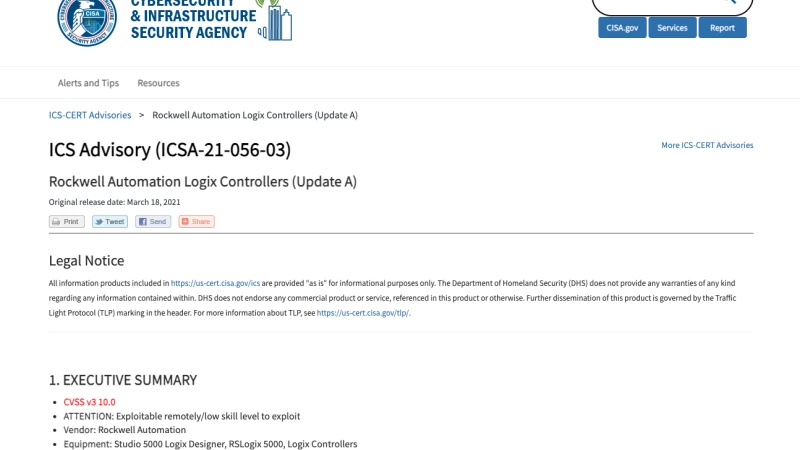
The Claroty Research Team has discovered a severe vulnerability (CVE-2021-22681, CVSS 10.0) in a mechanism that verifies communication between Rockwell Automation PLCs and engineering stations. The vulnerability affects Studio 5000 Logix Designer, RSLogix 5000, and many Logix Controllers.
Exploiting this flaw enables an attacker to remotely connect to almost any of the company's Logix programmable logic controllers (PLCs), and upload malicious code, download information from the PLC, or install new firmware.
The vulnerability lies in the fact that Studio 5000 Logix Designer software may allow a secret cryptographic key to be discovered. This key is used to verify communication between Rockwell Logix controllers and their engineering stations. If successfully exploited, this vulnerability could allow a remote, unauthenticated attacker to bypass this verification mechanism and connect to Logix controllers.
An attacker who is able to extract the secret key would be able to authenticate to any Rockwell Logix controller. These secret keys digitally sign all communication with the Rockwell PLCs; the PLCs verify the signature and authorize communication between it and the Rockwell engineering software. An attacker with this key could mimic a workstation and therefore be able to manipulate configurations or code running on the PLC (upload/download logic), and directly impact a manufacturing process.
Affected versions include: Rockwell's Studio 5000 Logix Designer (versions 21 and later) and RSLogix 5000 (versions 16-20), as well as Rockwell Logix Controllers (CompactLogix 1768, 1769, 5370, 5380, 5480, 5550, 5560, 5570, 5580), Drive Logix (5560, 5730, 1794-L34), Compact GuardLogix (5370 and 5380), GuardLogix (5570 and 5580), and SoftLogix 5800.
An advisory published Thursday by the Industrial Control System Cyber Emergency Response Team (ICS-CERT), describes the vulnerability as requiring low skill level to exploit.
Claroty privately disclosed the flaw to Rockwell in 2019; researchers from South Korea's Soonchunhyang University's Lab of Information Systems Security Assurance, and Kaspersky Lab, were also credited by ICS-CERT as having independently discovered the vulnerability.
Rockwell Automation recommends a number of specific mitigations including putting the controller's mode switch to "Run" mode and deploying CIP Security for Logix Designer connections. CIP Security prevents unauthorized connections when deployed properly.
Rockwell Automation also recommends a number of generic mitigations to blunt the effects of this vulnerability, starting with proper network segmentation and security controls such as minimizing exposure of control systems to the network or the internet. Control systems, Rockwell said, should be behind firewalls and isolated from other networks whenever feasible. Secure remote access is also suggested; at a minimum, using a VPN to connect to a device.
The ICS-CERT advisory includes all Rockwell mitigation advice, including a number of recommendations for each product family and version. It also recommends a number of detection methods if users suspect configurations have been modified. Those include:
Monitor controller change log for any unexpected modifications or anomalous activity.
If using v17 or later, utilize the Controller Log feature.
If using v20 or later, utilize Change Detection in the Logix Designer Application.
If available, use the functionality in FactoryTalk AssetCentre to detect changes.

CWE-79 IMPROPER NEUTRALIZATION OF INPUT DURING WEB PAGE GENERATION ('CROSS-SITE SCRIPTING')
The affected product is vulnerable to a reflected cross-site scripting vulnerability, which could allow a remote attacker to execute arbitrary JavaScript on the victim's browser.
Zenitel recommends users to upgrade to Version 9.3.3.0 or later.
CVSS v3: 9.8
CWE-787 OUT-OF-BOUNDS WRITE
The affected product is vulnerable to an out-of-bounds write vulnerability, which could allow a remote attacker to crash the device.
Zenitel recommends users to upgrade to Version 9.3.3.0 or later
CVSS v3: 7.6
CWE-78 IMPROPER NEUTRALIZATION OF SPECIAL ELEMENTS USED IN AN OS COMMAND ('OS COMMAND INJECTION')
An OS command injection vulnerability exists due to incomplete validation of user-supplied input. Validation fails to enforce sufficient formatting rules, which could permit attackers to append arbitrary data. This could allow an unauthenticated attacker to inject arbitrary commands.
Zenitel recommends users to upgrade to Version 9.3.3.0 or later
CVSS v3: 9.8
CWE-78 IMPROPER NEUTRALIZATION OF SPECIAL ELEMENTS USED IN AN OS COMMAND ('OS COMMAND INJECTION')
An OS command injection vulnerability exists due to insufficient sanitization of user-supplied input. The application accepts parameters that are later incorporated into OS commands without adequate validation. This could allow an unauthenticated attacker to execute arbitrary commands remotely.
Zenitel recommends users to upgrade to Version 9.3.3.0 or later.
CVSS v3: 9.8
CWE-78 IMPROPER NEUTRALIZATION OF SPECIAL ELEMENTS USED IN AN OS COMMAND ('OS COMMAND INJECTION')
An OS command injection vulnerability exists due to improper input validation. The application accepts a parameter directly from user input without verifying it is a valid IP address or filtering potentially malicious characters. This could allow an unauthenticated attacker to inject arbitrary commands.
Zenitel recommends users to upgrade to Version 9.3.3.0 or later
CVSS v3: 9.8